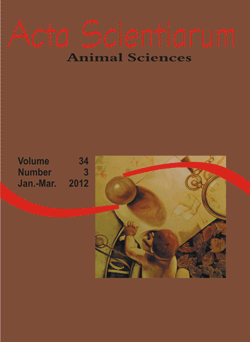<b>Growth and gastrointestinal indices in Nile tilapia fed with different diets</b> - doi: 10.4025/actascianimsci.v34i3.13327
Abstract
The adequate diet of Nile tilapia in their growth early stages is fundamental to the success of culture subsequent stages. The goal of the present work was to evaluate the Nile tilapia growth fed with different diets, and to morphometrically characterized the gastrointestinal tract of this species. The treatments consisted of three diets: (D1) natural food, (D2), commercial feed and (D3) commercial feed + natural food. In the qualitative phytoplankton analysis, there was greater representation of the genus Chlorella, while zooplankton community analysis revealed greater number of Brachionus rotifer. Growth and survival in D2 and D3 did not reveal differences (p > 0.05), while in D1, the results were significantly lower (p < 0.05). The gastro-somatic and entero-somatic indices, and the intestinal quotient revealed higher values when only natural food was available. Nile tilapia reached best zootechnical performance when commercial feed was included in the diet. The intake of natural and/or artificial food is related to the growth and development of the gastrointestinal indices, emphasizing that these indicators can be altered by the type of feeding.
Downloads
DECLARATION OF ORIGINALITY AND COPYRIGHTS
- I Declare that current article is original and has not been submitted for publication, in part or in whole, to any other national or international journal.
The copyrights belong exclusively to the authors. Published content is licensed under Creative Commons Attribution 4.0 (CC BY 4.0) guidelines, which allows sharing (copy and distribution of the material in any medium or format) and adaptation (remix, transform, and build upon the material) for any purpose, even commercially, under the terms of attribution.
Read this link for further information on how to use CC BY 4.0 properly.








































